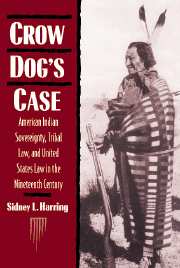 Crow Dog's Case
Crow Dog's Case Published online by Cambridge University Press: 23 September 2009
In a very real sense this whole inquiry is anomalous: every schoolchild in this country knows that the history of the incorporation of the Indian tribes into the United States was one of great violence and illegality. If anything, the real history is worse: the popular images are of parties of armed warriors combating troops of cavalry, not the genocide of starvation, smallpox, tuberculosis, the shooting of villages full of women and children. This genocide is beyond the scope of legal history, but in reality such events reflect U.S. legal choices. The Indian wars were legal events from two perspectives. First, U.S. policymakers' decision to permit settlers to continue pushing back the Indian frontier was the most direct cause of the Indian wars. In its failure to police the frontier effectively, the federal government left a lawless void, whereas Canada, for example, almost entirely avoided Indian warfare by policing frontier whites. Second, the Indians fought wars against whites to enforce their law and protect their legal rights against white illegality. The Indian wars do not reflect “villainy” on the part of the tribes as Justice William Rehnquist asserts in a dissent (conceding “greed, cupidity, and other less than admirable behavior” on the part of the government), disagreeing with the U.S. Supreme Court's weak attempt to redress wrongs committed by the United States against the Sioux in illegally seizing the Black Hills.
To save this book to your Kindle, first ensure [email protected] is added to your Approved Personal Document E-mail List under your Personal Document Settings on the Manage Your Content and Devices page of your Amazon account. Then enter the ‘name’ part of your Kindle email address below. Find out more about saving to your Kindle.
Note you can select to save to either the @free.kindle.com or @kindle.com variations. ‘@free.kindle.com’ emails are free but can only be saved to your device when it is connected to wi-fi. ‘@kindle.com’ emails can be delivered even when you are not connected to wi-fi, but note that service fees apply.
Find out more about the Kindle Personal Document Service.
To save content items to your account, please confirm that you agree to abide by our usage policies. If this is the first time you use this feature, you will be asked to authorise Cambridge Core to connect with your account. Find out more about saving content to Dropbox.
To save content items to your account, please confirm that you agree to abide by our usage policies. If this is the first time you use this feature, you will be asked to authorise Cambridge Core to connect with your account. Find out more about saving content to Google Drive.